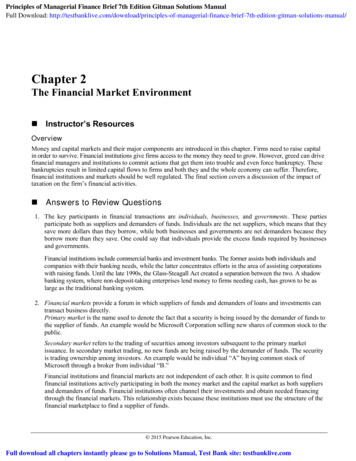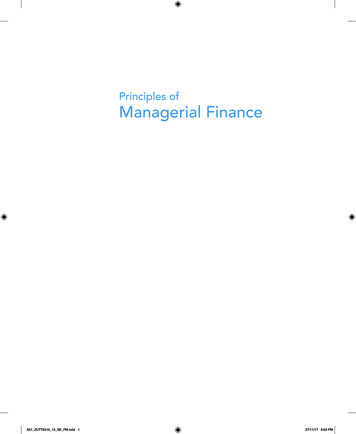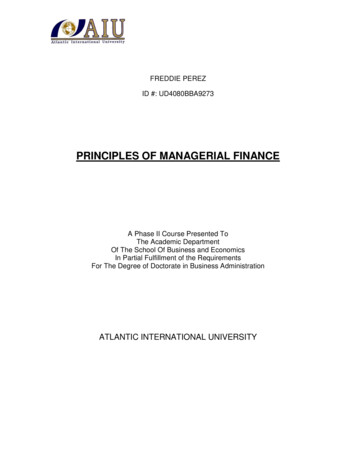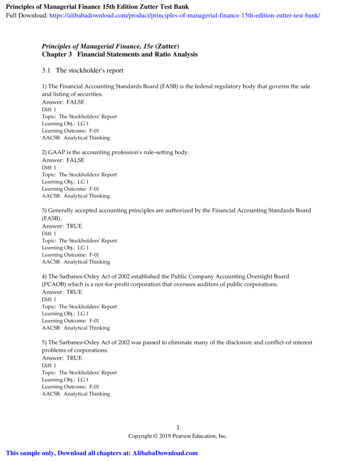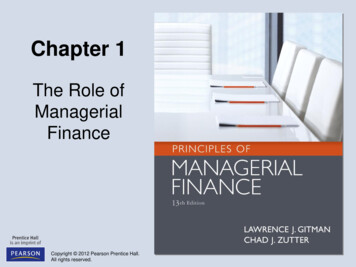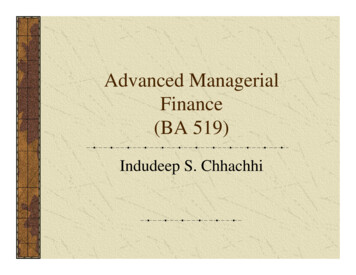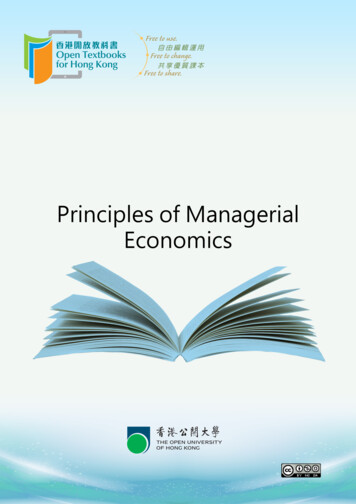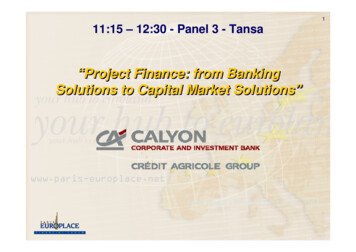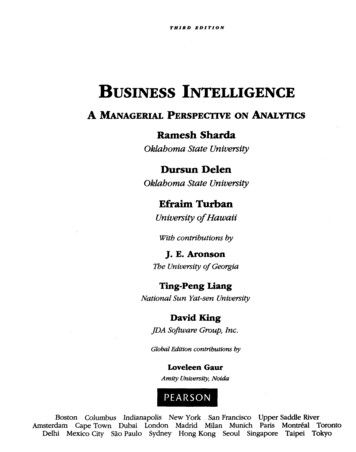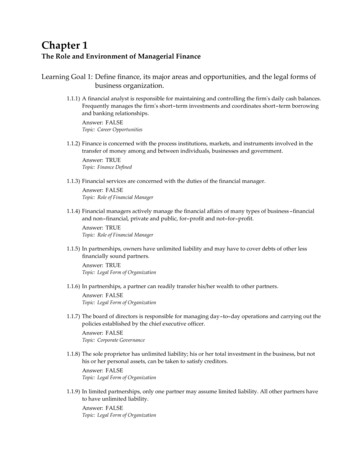
Transcription
Chapter 1The Role and Environment of Managerial FinanceLearning Goal 1: Define finance, its major areas and opportunities, and the legal forms ofbusiness organization.1.1.1) A financial analyst is responsible for maintaining and controlling the firmʹs daily cash balances.Frequently manages the firmʹs short-term investments and coordinates short-term borrowingand banking relationships.Answer: FALSETopic: Career Opportunities1.1.2) Finance is concerned with the process institutions, markets, and instruments involved in thetransfer of money among and between individuals, businesses and government.Answer: TRUETopic: Finance Defined1.1.3) Financial services are concerned with the duties of the financial manager.Answer: FALSETopic: Role of Financial Manager1.1.4) Financial managers actively manage the financial affairs of many types of business -financialand non-financial, private and public, for-profit and not-for-profit.Answer: TRUETopic: Role of Financial Manager1.1.5) In partnerships, owners have unlimited liability and may have to cover debts of other lessfinancially sound partners.Answer: TRUETopic: Legal Form of Organization1.1.6) In partnerships, a partner can readily transfer his/her wealth to other partners.Answer: FALSETopic: Legal Form of Organization1.1.7) The board of directors is responsible for managing day-to-day operations and carrying out thepolicies established by the chief executive officer.Answer: FALSETopic: Corporate Governance1.1.8) The sole proprietor has unlimited liability; his or her total investment in the business, but nothis or her personal assets, can be taken to satisfy creditors.Answer: FALSETopic: Legal Form of Organization1.1.9) In limited partnerships, only one partner may assume limited liability. All other partners haveto have unlimited liability.Answer: FALSETopic: Legal Form of Organization
2Gitman · Principles of Managerial Finance, 12e1.1.10) The president or chief executive officer is elected by the firmʹs stockholders and has ultimateauthority to guide corporate affairs and make general policy.Answer: FALSETopic: Corporate Governance1.1.11) In limited partnerships, all partnersʹ liabilities are limited to their investment in thepartnership.Answer: FALSETopic: Legal Form of Organization1.1.12) In limited liability partnerships, the liability protection does not protect partners from theirown individual acts of malpractice.Answer: TRUETopic: Legal Form of Organization1.1.13) The capital expenditures analyst/manager is responsible for the evaluation andrecommendation of proposed asset investments and may be involved in the financial aspects ofimplementation of approved investments.Answer: TRUETopic: Managerial Finance Functions1.1.14) The financial analyst administers the firmʹs credit policy by analyzing or managing theevaluation of credit applications, extending credit, and monitoring and collecting accountsreceivable.Answer: FALSETopic: Managerial Finance Functions1.1.15) In large companies, the project finance manager is responsible for coordinating the assets andliabilities of the employeesʹ pension fund.Answer: FALSETopic: Managerial Finance Functions1.1.16) In S corporations, stockholders receive all of the organizational benefits of a corporation andthe tax advantages of a partnership, but lose certain tax advantages related to pension plansthat are available to traditional corporations.Answer: TRUETopic: Legal Form of Organization1.1.17) Unlike an S corporation, the limited liability corporation (LLC) can own more than 80 percentof another corporation, and corporations, partnerships, or non -U.S. residents can own limitedliability corporation shares.Answer: TRUETopic: Legal Form of Organization1.1.18) In limited liability partnership, all partners have limited liability with regard to the business they are not personally liable for other partnersʹ malpractice and the limited liabilitypartnership is taxed as partnership.Answer: TRUETopic: Legal Form of Organization
Chapter 1The Role and Environment of Managerial Finance1.1.19) The part of finance concerned with design and delivery of advice and financial products toindividuals, business, and government is calledA) Managerial Finance.B) Financial Manager.C) Financial Services.D) none of the above.Answer: CTopic: Managerial Finance Functions1.1.20) Managerial financeA) involves tasks such as budgeting, financial forecasting, cash management, and fundsprocurement.B) involves the design and delivery of advice and financial products.C) recognizes funds on an accrual basis.D) devotes the majority of its attention to the collection and presentation of financial data.Answer: ATopic: Managerial Finance Functions1.1.21) Finance can be defined asA) the system of debits and credits.B) the science of the production, distribution, and consumption of wealth.C) the art and science of managing money.D) the art of merchandising products and services.Answer: CTopic: Finance Defined1.1.22) Financial serviceA) is concerned with the duties of the financial manager.B) involves the design and delivery of advice and financial products.C) provides guidelines for the efficient operation of the business.D) handles accounting activities related to data processing.Answer: BTopic: Career Opportunities1.1.23) Career opportunities in financial services include all of the following EXCEPTA) investments.B) real estate and insurance.C) capital expenditures management.D) personal financial planning.Answer: CTopic: Career Opportunities1.1.24) Which of the following is a career opportunity in managerial finance?A) Investment.B) Real Estate and Insurance.C) Capital expenditures Management.D) Personal Financial Planning.Answer: CTopic: Career Opportunities3
4Gitman · Principles of Managerial Finance, 12e1.1.25) Which of the following legal forms of organization is most expensive to organize?A) Sole proprietorships.B) Partnerships.C) Corporations.D) Limited partnership.Answer: CTopic: Legal Form of Organization1.1.26) Which of the following legal forms of organizationʹs income is NOT taxed under individualincome tax rate?A) Sole proprietorships.B) Partnerships.C) Limited partnership.D) Corporation.Answer: DTopic: Legal Form of Organization1.1.27) Under which of the following legal forms of organization, is ownership readily transferable?A) Sole proprietorships.B) Partnerships.C) Limited partnership.D) Corporation.Answer: DTopic: Legal Form of Organization1.1.28) The true owner(s) of the corporation is (are) the .A) board of directorsB) chief executive officerC) stockholdersD) creditorsAnswer: CTopic: Corporate Governance1.1.29) The has/have the ultimate responsibility in guiding corporate affairs and carrying outpolicies.A) board of directorsB) chief executive officerC) stockholdersD) creditorsAnswer: ATopic: Corporate Governance1.1.30) The responsibility for managing day-to-day operations and carrying out corporate policiesbelongs to the .A) board of directorsB) chief executive officerC) stockholdersD) creditorsAnswer: BTopic: Corporate Governance
Chapter 1The Role and Environment of Managerial Finance1.1.31) In a corporation, the members of the board of directors are elected by theA) chief executive officer.B) creditors.C) stockholders.D) employees.Answer: CTopic: Corporate Governance1.1.32) is concerned with the duties of the financial manager in the business firm.A) Financial ServicesB) Financial ManagerC) Managerial FinanceD) None of the aboveAnswer: CTopic: Role of Financial Manager1.1.33) About 75 percent of all business firms areA) sole proprietorships.B) partnerships.C) corporations.D) S-corporations.Answer: ATopic: Legal Form of Organization1.1.34) A major weakness of a partnership isA) limited liability.B) difficulty liquidating or transferring ownership.C) access to capital markets.D) low organizational costs.Answer: BTopic: Legal Form of Organization1.1.35) All of the following are key strengths of a corporation EXCEPTA) access to capital markets.B) limited liability.C) low organization costs.D) readily transferable ownership.Answer: CTopic: Legal Form of Organization1.1.36) Which of the following legal forms of organization is characterized by limited liability?A) Sole proprietorship.B) Partnership.C) Corporation.D) Professional partnership.Answer: CTopic: Legal Form of Organization5
6Gitman · Principles of Managerial Finance, 12e1.1.37) The dominant form of organization with respect to receipts and net profits is theA) sole proprietorship.B) partnership.C) corporation.D) S-corporation.Answer: CTopic: Legal Form of Organization1.1.38) A ʺlegal entityʺ which can sue and be sued, make and be party to contracts, and acquireproperty in its own name isA) a sole proprietorship.B) a partnership.C) a corporation.D) a professional partnership.Answer: CTopic: Legal Form of Organization1.1.39) The is responsible for evaluating and recommending proposed asset investments.A) Financial AnalystB) Credit AnalystC) Pension Fund ManagerD) Capital Expenditures AnalystAnswer: DTopic: Managerial Finance Functions1.1.40) In a(n) , owners have limited liability with regard to the business. They are notpersonally liable for the malpractice of other owners.A) limited partnershipB) S-corporationC) partnershipD) limited liability partnershipAnswer: DTopic: Legal Form of OrganizationLearning Goal 2: Describe the managerial finance function and its relationship to economicsand accounting.1.2.1) Marginal analysis states that financial decisions should be made and actions taken only whenadded benefits exceeds added costs.Answer: TRUETopic: Fundamental Concepts1.2.2) The corporate controller typically handles the accounting activities, such as tax management,data processing, and cost and financial accounting.Answer: TRUETopic: Managerial Finance Functions1.2.3) The financial manager places primary emphasis on cash flows, the inflow and outflow of cash.Answer: TRUETopic: Fundamental Concepts
Chapter 1The Role and Environment of Managerial Finance1.2.4) Managerial finance is concerned with design and delivery of advice and financial products toindividuals, business, and government.Answer: FALSETopic: Managerial Finance Functions1.2.5) The corporate treasurer typically handles the both cost accounting and financial accounting.Answer: FALSETopic: Managerial Finance Functions1.2.6) The accrual method recognizes revenue at the point of sale and recognizes expenses whenincurred.Answer: TRUETopic: Accounting Concepts1.2.7) The accountant evaluates financial statements, develops additional data, and makes decisionsbased on his or her assessment of the associated returns and risks.Answer: FALSETopic: Accounting Concepts1.2.8) The corporate treasurer is the officer responsible for the firmʹs accounting activities, such ascorporate accounting, tax management, financial accounting, and cost accounting.Answer: FALSETopic: Managerial Finance Functions1.2.9) The corporate controller is the officer responsible for the firmʹs financial activities such asfinancial planning and fund raising, making capital expenditure decisions, and managing cash,credit, the pension fund, and foreign exchange.Answer: FALSETopic: Managerial Finance Functions1.2.10) High cash flow is generally associated with a higher share price whereas higher risk tends toresult in a lower share price.Answer: TRUETopic: Fundamental Concepts1.2.11) The corporate treasurerʹs focus tends to be more external, while the controllerʹs focus is moreinternal.Answer: TRUETopic: Managerial Finance Functions1.2.12) The financial manager prepares financial statements that recognize revenue at the point of saleand expenses when incurred.Answer: FALSETopic: Role of Financial Manager1.2.13) Using certain standardized and generally accepted principles, the accountant preparesfinancial statements that recognize revenue at the point of sale and expenses when incurred.Answer: TRUETopic: Accounting Concepts7
8Gitman · Principles of Managerial Finance, 12e1.2.14) The financial manager must look beyond financial statements to obtain insight into developingor existing problems since the accrual accounting data do not fully describe the circumstancesof a firm.Answer: TRUETopic: Role of Financial Manager1.2.15) Managerial financeA) involves tasks such as budgeting, financial forecasting, cash management, and fundsprocurement.B) involves the design and delivery of advice and financial products.C) recognizes funds on an accrual basis.D) devotes the majority of its attention to the collection and presentation of financial data.Answer: ATopic: Managerial Finance Functions1.2.16) The treasurer is commonly responsible forA) taxes.B) data processing.C) making capital expenditures.D) cost accounting.Answer: CTopic: Managerial Finance Functions1.2.17) The controller is commonly responsible forA) managing cash.B) financial accounting.C) managing credit activities.D) financial planning.Answer: BTopic: Managerial Finance Functions1.2.18) The accountantʹs primary function isA) evaluating the financial statements.B) making decisions based on financial data.C) the collection and presentation of financial data.D) planning cash flows.Answer: CTopic: Accounting Concepts1.2.19) The accountant recognizes revenues and expenses onA) a cash basis.B) a revenue basis.C) an accrual basis.D) an expense basis.Answer: CTopic: Accounting Concepts
Chapter 1The Role and Environment of Managerial Finance1.2.20) The financial manager recognizes revenues and expenses utilizingA) the accrual method.B) the actual inflows and outflows of cash.C) the standardized, generally accepted, accounting principles.D) the revenue method.Answer: BTopic: Role of Financial Manager1.2.21) The financial manager is interested in the cash inflows and outflows of the firm, rather than theaccounting data, in order to ensureA) profitability.B) the ability to pay dividends.C) the ability to acquire new assets.D) solvency.Answer: DTopic: Role of Financial Manager1.2.22) The accountant may be responsible for any of the following EXCEPTA) processing purchase orders and invoices.B) ensuring accounts payable are paid on time.C) preparing the monthly income statement.D) analyzing the mix of current to fixed assets.Answer: DTopic: Accounting Concepts1.2.23) Economic theories that the financial manager must be able to utilize for efficient businessoperations, includeA) supply-and-demand analysis.B) marginal analysis.C) profit-maximizing strategies.D) price theory.E) all of the above.Answer: ETopic: Fundamental Concepts1.2.24) The primary economic principle used in managerial finance isA) supply and demand.B) the liquidity trap.C) the crowding out effect.D) marginal analysis.Answer: DTopic: Fundamental Concepts9
10Gitman · Principles of Managerial Finance, 12e1.2.25) Johnson, Inc. has just ended the calendar year making a sale in the amount of 10,000 ofmerchandise purchased during the year at a total cost of 7,000. Although the firm paid in fullfor the merchandise during the year, it has yet to collect at year end from the customer. The netprofit and cash flow from this sale for the year areA) 3,000 and 10,000, respectively.B) 3,000 and - 7,000, respectively.C) 7,000 and - 3,000, respectively.D) 3,000 and 7,000, respectively.Answer: BTopic: Fundamental Concepts1.2.26) A firm has just ended its calendar year making a sale in the amount of 150,000 of merchandisepurchased during the year at a total cost of 112,500. Although the firm paid in full for themerchandise during the year, it has yet to collect at year end from the customer. The net profitand cash flow from this sale for the year areA) 0 and 150,000, respectively.B) 37,500 and - 150,000, respectively.C) 37,500 and - 112,500, respectively.D) 150,000 and 112,500, respectively.Answer: CTopic: Fundamental Concepts1.2.27) The primary emphasis of the financial manager is the use ofA) accrued earnings.B) cash flow.C) organization charts.D) profit incentives.Answer: BTopic: Role of Financial Manager1.2.28) By concentrating on cash flows within the firm the financial manager should be able toA) prepare tax returns.B) speak authoritatively to stockholders.C) avoid insolvency.D) control expenses.Answer: CTopic: Role of Financial Manager1.2.29) The officer responsible for the firmʹs financial activities such as financial planning and fundraising, making capital expenditure decisions, and managing cash, credit, the pension fund,and foreign exchange isA) treasurer.B) controller.C) foreign exchange manager.D) none of the above.Answer: ATopic: Managerial Finance Functions
Chapter 1The Role and Environment of Managerial Finance1.2.30) Marginal analysis states that financial decisions should be made and actions taken only whenA) demand equals supply.B) benefits equal costs.C) added benefits exceed added costs.D) added benefits are greater than zero.Answer: CTopic: Fundamental Concepts1.2.31) The officer responsible for the firmʹs accounting activities, such as corporate accounting, taxmanagement, financial accounting, and cost accounting is theA) treasurer.B) controller.C) foreign exchange manager.D) none of the above.Answer: BTopic: Managerial Finance Functions1.2.32) A firm has just ended its calendar year making a sale in the amount of 200,000 of merchandisepurchased during the year at a total cost of 150,500. Although the firm paid in full for themerchandise during the year, it has yet to collect at year end from the customer. The possibleproblem this firm may face isA) low profitability.B) lack of cash flow.C) inability to receive credit.D) high leverage.Answer: BTopic: Fundamental ConceptsLearning Goal 3: Identify the primary activities of the financial manager.1.3.1) When considering each financial decision alternative or possible action in terms of its impacton the share price of the firmʹs stock, financial managers should accept only those actions thatare expected to increase the firmʹs profitability.Answer: FALSETopic: Goal of the Firm1.3.2) Financial analysis and planning is concerned with analyzing the mix of assets and liabilities.Answer: FALSETopic: Managerial Finance Functions1.3.3) Financing decisions deal with the left-hand side of the firmʹs balance sheet and involve themost appropriate mix of current and fixed assets.Answer: FALSETopic: Managerial Finance Functions11
12Gitman · Principles of Managerial Finance, 12e1.3.4) The key role of the financial manager isA) decision making.B) the presentation of financial statements.C) the preparation of data for future evaluation.D) the collection of financial data.Answer: ATopic: Role of Financial Manager1.3.5) The key activities of the financial manager include all of the following EXCEPTA) making financing decisions.B) financial analysis and planning.C) managing financial accounting.D) making investment decisions.Answer: CTopic: Role of Financial Manager1.3.6) Included in the primary activities of the financial manager areA) financial analysis and planning.B) making investment decisions.C) making financing decisions.D) analyzing and planning cash flows.E) all of the above.Answer: ETopic: Role of Financial Manager1.3.7) The financial manager may be responsible for any of the following EXCEPTA) monitoring of quarterly tax payments.B) analyzing budget and performance reports.C) determining whether to accept or reject a capital asset acquisition.D) analyzing the effects of more debt on the firmʹs capital structure.Answer: ATopic: Role of Financial Manager1.3.8) Making investment decisions includes all of the following EXCEPTA) inventory.B) fixed assets.C) accounts receivable.D) notes payable.Answer: DTopic: Managerial Finance Functions1.3.9) Making financing decisions includes all of the following EXCEPTA) determining the appropriate mix of short-term and long-term financing.B) deciding which individual short-term sources are best at a given point in time.C) analyzing quarterly budget and performance repor
The Role and Environment of Managerial Finance Learning Goal 1: Define finance, its major areas and opportunities, and the legal forms of business organization. 1.1.1) A financial analyst is responsible for maintaining and controlling the firmʹs daily cash balances. Frequently manages th
